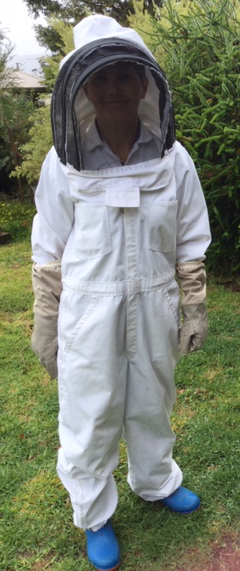As a beekeeper, choosing the type of protective clothing is important – but it’s also necessary to consider what you will wear underneath your suit. The main thing to remember is that the majority of beekeeping duties are performed when the weather is warm, during summer, spring, or fall.
Hive inspections are often physically demanding and involve moving around heavy hive boxes and frames (hopefully) laden with honey, so it’s important that you don’t get too hot or uncomfortable and can move around freely in your suit. As such, you want to wear light, breathable clothes underneath to help you remain as comfortable as possible.
What Type Of Bee Suit Do You Have?
What you wear underneath will also depend somewhat on the type of bee suit you have. There are several types of beekeeping suits and jackets available. We’ve covered protective clothing in another post which you can check out, but what you purchase depends on your budget, how much protection you want, and how comfortable the suit or beekeeping jacket is to wear.
I wanted maximum protection from being stung, so I bought a long-sleeved, full-length suit with a hood and netting on the front. The hood looks a bit like the one people wear during fencing competitions!

The fabric is cotton and quite cool, however, even the smallest size suit proved to be too big for me. I also bought leather gloves with gauntlets that go well past my elbows.
Underneath this impenetrable exterior, I realized I needed to wear lightweight breathable clothing so I didn’t get too hot too quickly. Many beekeeping tasks take quite a while, and I want to ensure I don’t become exhausted or dehydrated halfway through. It’s not easy to run off and make a quick costume change if you get too hot when inspecting your hive!
What To Wear On Your Torso
I suggest you have several different options available to wear underneath your beekeeping suit. Choose tops that are breathable, fit comfortably, can be machine washed and are not new, because you will perspire quite a bit under your suit. I have a selection of old clothes I use specifically for beekeeping, so it doesn’t matter if they get damaged.
T-shirts or lightweight long-sleeved shirts made from a natural fiber such as cotton are ideal.
I find synthetic materials are scratchy and irritate my skin, especially when I get hot.
I like to wear tops with long sleeves because of the extra protection they give my arms against the possibility of being stung. Of course, if your suit is thick and heavy enough to prevent bees from stinging you through it, you may prefer to wear something with short sleeves.
Naturally, you will perspire, especially when you have to conduct a full inspection (or more than one) that involves lifting heavy hive boxes and frames around. Therefore you want the top you wear under your suit to help absorb perspiration and remain comfortable.
In terms of color, it’s probably better to wear light colors which reflect heat, rather than dark colors that absorb it. I know the top will be under your suit anyway and you won’t see it, but light-colored fabrics feel cooler on your skin to begin with.
What To Wear On Your Legs
Wear comfortable pants (trousers if you are in the UK) or shorts under your beekeeping suit, made of a lightweight material that allows you to move easily. I prefer natural fibers that don’t rub and irritate my legs or cause static, but you should wear whatever feels most comfortable for you.
If you have a beekeeping jacket instead of a full-length suit, you will need to wear lightweight, comfortable full-length pants to protect your legs. Long socks are also a good idea, which you should tuck your pants into – it’s not the most fashionable look, but it will create a seal that keeps out bees.
Wear light-colored pants that reflect the heat and keep your legs cool.
If you are spending some time working in the hive moving heavy boxes and frames, then you will become very warm and uncomfortable in pants made of heavy material. For that reason, I tend to avoid wearing jeans, even though the thick material will protect against stings.
What To Wear On Your Head
Inside the veiled hood of your beekeeping suit it gets incredibly hot. Think of it like being inside a mini greenhouse – you will sweat a lot! When you’re covered from head to toe, it becomes impossible to wipe away any perspiration with the back of your hand.
As you can imagine, this is incredibly frustrating. Sweat running into your eyes can sting and affect your vision and concentration, which is far from ideal when inspecting your hive.
There are several options you could choose to wear underneath your hood to help stop this from happening. A wet handkerchief or bandana around your forehead or neck can be surprisingly effective and prevent the sweat from running down your face and into your eyes. I also know beekeepers who wear a headband to accomplish the same result.
I don’t have a huge problem with perspiration, so I’ve never needed a bandana or headband. However, I do wear a baseball cap underneath. The peak helps keep the wire veil from touching my face even when it’s windy, and protects me from the possibility of getting a bee sting in that sensitive area.
Conclusion
Beekeeping involves many different tasks and, at times, can be very physically demanding. Comfortable and breathable clothing will reduce your chance of exhaustion and dehydration, which can negatively affect your health. The right type of clothing will also help you care for your hive to the best of your ability while remaining comfortable and happy.
